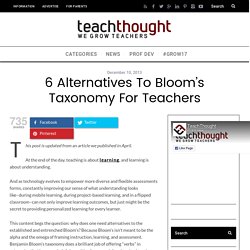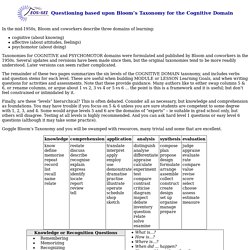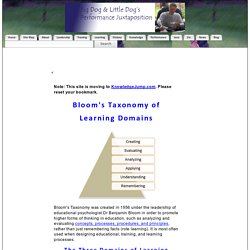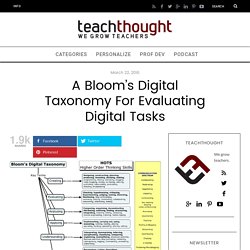

Blooms Taxonomy Best. Untitled. 6 Alternatives To Bloom's Taxonomy For Teachers - This post is updated from an article we published in April.

At the end of the day, teaching is about learning, and learning is about understanding. And as technology evolves to empower more diverse and flexible assessments forms, constantly improving our sense of what understanding looks like–during mobile learning, during project-based learning, and in a flipped classroom–can not only improve learning outcomes, but just might be the secret to providing personalized learning for every learner. This content begs the question: why does one need alternatives to the established and entrenched Bloom’s? Because Bloom’s isn’t meant to be the alpha and the omega of framing instruction, learning, and assessment. So with apologies to Bloom (whose work we covered recently), we have gathered five alternatives to his legendary, world-beating taxonomy, from the TeachThought Simple Taxonomy, to work from Marzano to Fink, to the crew at Understanding by Design.
126 Bloom's Taxonomy Verbs For Digital Learning - By TeachThought Staff You can get a ready-for-the-classroom version of Bloom’s Digital Taxonomy for $6.95.

At TeachThought, we’re enthusiastic supporters of any learning taxonomy. (We even created our own, the TeachThought Learning Taxonomy.) Put simply, learning taxonomies help us think about how learning happens. Even if they’re ‘not good’ as we’ve often seen the DOK framework described, they still highlight that there are many ways to frame thinking and give us practice in realizing that potential. This means that we can have taxonomies for differentiation and taxonomies for thinking and taxonomies for tasks and assessment–so many possibilities for examining the actual process of thinking, learning, and the application of each. 50 Resources For Teaching With Bloom's Taxonomy - Bloom's Taxonomy and Assessments. Questioning based upon Bloom’s Taxonomy for the Cognitive Domain. Questioning based upon Bloom’s Taxonomy for the Cognitive Domain In the mid-1950s, Bloom and coworkers describe three domains of learning: cognitive (about knowing) affective (about attitudes, feelings) psychomotor (about doing) Taxonomies for COGNITIVE and PSYCHOMOTOR domains were formulated and published by Bloom and coworkers in the 1950s.

Several updates and revisions have been made since then, but the original taxonomies tend to be more readily understood. Later versions can seem rather complicated. The remainder of these two pages summarizes the six levels of the COGNITIVE DOMAIN taxonomy, and includes verbs and question stems for each level. Finally, are these “levels” hierarchical? Creative Visualizations of Bloom's Taxonomies! Bloom's Taxonomy of Learning Domains: The Cognitive Domain. Bloom's Taxonomy was created in 1956 under the leadership of educational psychologist Dr Benjamin Bloom in order to promote higher forms of thinking in education, such as analyzing and evaluating concepts, processes, procedures, and principles, rather than just remembering facts (rote learning).

It is most often used when designing educational, training, and learning processes. The Three Domains of Learning The committee identified three domains of educational activities or learning (Bloom, et al. 1956): Cognitive: mental skills (knowledge) Affective: growth in feelings or emotional areas (attitude or self) Psychomotor: manual or physical skills (skills) Since the work was produced by higher education, the words tend to be a little bigger than we normally use. While the committee produced an elaborate compilation for the cognitive and affective domains, they omitted the psychomotor domain. Cognitive Domain Knowledge Comprehension Application Analysis Synthesis Evaluation Next Steps Review. A Bloom's Digital Taxonomy For Evaluating Digital Tasks. A Bloom’s Digital Taxonomy For Evaluating Digital Tasks by TeachThought Staff What makes Bloom’s Taxonomy such a power tool is its flexibility in framing almost anything–which is why you’ve been seeing a lot of it around lately, and will likely continue to.

Whether you’re creating a checklist for instructional design, evaluating an assessment, skimming a favorite unit of yours, or using it as a walk-through instrument to get a feel for the level of student thinking in a classroom, Bloom’s Taxonomy is a powerful tool for any educator at any level. Blooms Taxonomy Teacher Planning Kit. HIGHLAND LITERACY. Bloom's Digital Taxonomy Cheat Sheet for Teachers.